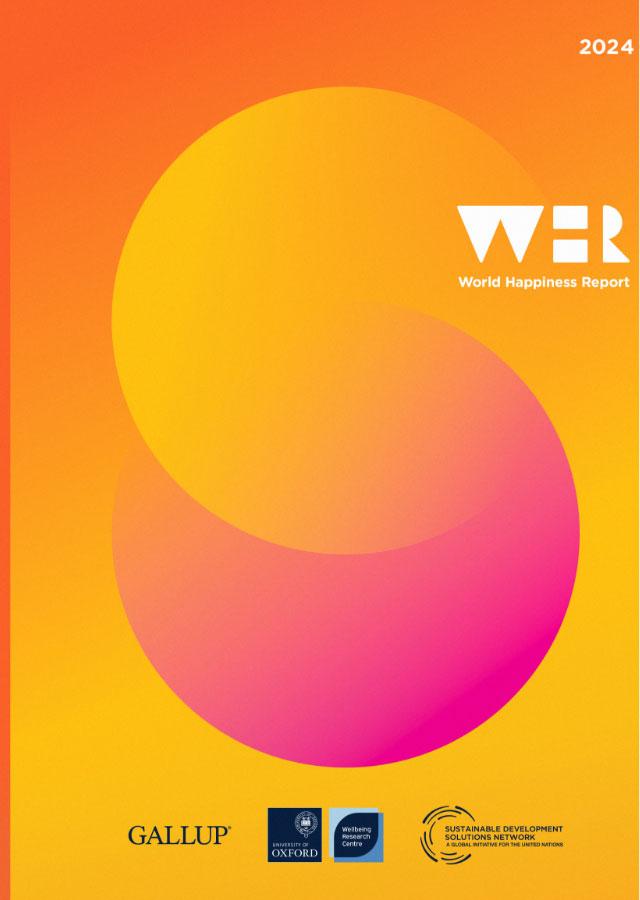World Happiness Report
Powered by Gallup, the World Happiness Report provides data-driven insights to the global conversation on happiness.
Thank you for downloading the World Happiness Report 2024.
You'll also receive an email with a link to download the report.
World Happiness Report 2024
The World Happiness Report is a partnership among Gallup, the Oxford Wellbeing Research Centre, the UN Sustainable Development Solutions Network and the World Happiness Report's Editorial Board.
The World Happiness Report has become an indispensable resource for satisfying the growing global interest in prioritizing happiness -- or wellbeing -- in government policymaking. Gallup's World Poll data on life evaluations are the primary source behind the annual happiness rankings for countries worldwide.
The report assesses the current state of happiness worldwide and explores how the field of happiness science illuminates the differences in happiness levels on an individual and national scale. The 2024 edition focuses on the happiness of people at different stages of life.

World Happiness Report 2024
The World Happiness Report is a partnership among Gallup, the Oxford Wellbeing Research Centre, the UN Sustainable Development Solutions Network and the World Happiness Report's Editorial Board.
The World Happiness Report has become an indispensable resource for satisfying the growing global interest in prioritizing happiness -- or wellbeing -- in government policymaking. Gallup's World Poll data on life evaluations are the primary source behind the annual happiness rankings for countries worldwide.
The report assesses the current state of happiness worldwide and explores how the field of happiness science illuminates the differences in happiness levels on an individual and national scale. The 2024 edition focuses on the happiness of people at different stages of life.
World Happiness
The World Happiness Report explores the factors contributing to human wellbeing, the happiness ratings of countries and the importance of measuring happiness.
Chapter 1: Happiness and Age: Summary
01 Happiness and Age: Summary
The executive summary of the World Happiness Report provides a concise overview of the key findings, analyses and recommendations presented in the full document. It serves as a snapshot encapsulating the main points for various audiences to grasp the essence of the report before delving into its entirety.
Download the Report to Get This Chapter --Happiness and Age: Summary
Chapter 2: Happiness of the Younger, the Older and Those in Between
02 Happiness of the Younger, the Older and Those in Between
This chapter focuses on happiness at different ages and among different generations. It explores life evaluations among the young, the old and those in between; compares country rankings for each age group; and shows how life evaluations at different ages have changed over the years.
The findings show that wellbeing inequality is generally greater at older ages (perhaps due to differences in health status increasing more among people as individuals age), but it has been increasing in all age groups in most global regions.
The chapter also discusses how some important parts of life are tied mainly to age, such as schooling, employment and health. Others depend more on what is going on in society and the world. These factors range from violence, earthquakes and pandemics to how new technologies and changing natural and social environments interact with ways of seeing history, facing inequalities and connecting with each other.

Download the Report to Get This Chapter --Happiness and Age: Summary
Chapter 3: Child and Adolescent Wellbeing: Global Trends, Challenges and Opportunities
03 Child and Adolescent Wellbeing: Global Trends, Challenges and Opportunities
The chapter begins by exploring life satisfaction levels and trends among children and adolescents, with consideration of regional, gender and age group variations. It offers an overview of current country-level life satisfaction in the post-pandemic world and how this varies across different age groups.
Subsequently, these analyses are used to examine inequalities across different sociodemographic groups and assess how factors within distinct life domains contribute to variations in adolescent life satisfaction.
An important aspect of this chapter is a discussion of the shortcomings of the available international data. It highlights actions that should be taken to improve data quantity and quality and thereby increase our understanding of child and adolescent wellbeing and how to improve it worldwide.

Chapter 4: Supporting the Wellbeing of an Aging Global Population: Associations Between Wellbeing and Dementia
04 Supporting the Wellbeing of an Aging Global Population: Associations Between Wellbeing and Dementia
By the year 2050, the World Health Organization estimates that the global population of people 65 and older will double. As the global population of older adults continues to rise, the number of people living with dementia is also expected to grow, reaching approximately 139 million dementia cases by the year 2050.
A growing body of evidence suggests that wellbeing may be a promising target for dementia-prevention efforts given its associations with better cognitive health and lower dementia risk.
This chapter explores why it is also crucial to evaluate and implement strategies to support the wellbeing of people living with dementia and their care partners. It concludes by discussing how research findings can inform policy to support the wellbeing of an aging global population.
Chapter 5: Differences in Life Satisfaction Among Older Adults in India
05 Differences in Life Satisfaction Among Older Adults in India

Older age is associated with higher life satisfaction in India
India's older population is the second largest worldwide, with 140 million Indians aged 60 and over, second only to their 250 million Chinese counterparts. Additionally, the average growth rate for Indians aged 60 and over is three times higher than the overall population growth rate of the country. Though population aging reflects social and economic progress, scientists across the globe continue to debate the factors that contribute to quality of life in older age.
This chapter fills the research gap about later-life subjective wellbeing in India by estimating the extent to which various sociodemographic, household and health-related factors contribute to the differences in life satisfaction among older adults. Satisfaction with living arrangements, perceived discrimination and self-rated health emerged as the top three predictors of life satisfaction in this study.
The findings showing older age is associated with higher life satisfaction in India refute some claims that the positive association between age and life satisfaction only exists in high-income nations.

Chapter 1: Happiness and Age: Summary
01 Happiness and Age: Summary
The executive summary of the World Happiness Report provides a concise overview of the key findings, analyses and recommendations presented in the full document. It serves as a snapshot encapsulating the main points for various audiences to grasp the essence of the report before delving into its entirety.
Chapter 2: Happiness of the Younger, the Older and Those in Between
02 Happiness of the Younger, the Older and Those in Between
This chapter focuses on happiness at different ages and among different generations. It explores life evaluations among the young, the old and those in between; compares country rankings for each age group; and shows how life evaluations at different ages have changed over the years.
The findings show that wellbeing inequality is generally greater at older ages (perhaps due to differences in health status increasing more among people as individuals age), but it has been increasing in all age groups in most global regions.
The chapter also discusses how some important parts of life are tied mainly to age, such as schooling, employment and health. Others depend more on what is going on in society and the world. These factors range from violence, earthquakes and pandemics to how new technologies and changing natural and social environments interact with ways of seeing history, facing inequalities and connecting with each other.

Chapter 3: Child and Adolescent Wellbeing: Global Trends, Challenges and Opportunities
03 Child and Adolescent Wellbeing: Global Trends, Challenges and Opportunities
The chapter begins by exploring life satisfaction levels and trends among children and adolescents, with consideration of regional, gender and age group variations. It offers an overview of current country-level life satisfaction in the post-pandemic world and how this varies across different age groups.
Subsequently, these analyses are used to examine inequalities across different sociodemographic groups and assess how factors within distinct life domains contribute to variations in adolescent life satisfaction.
An important aspect of this chapter is a discussion of the shortcomings of the available international data. It highlights actions that should be taken to improve data quantity and quality and thereby increase our understanding of child and adolescent wellbeing and how to improve it worldwide.

Download This Chapter --Child and Adolescent Well-Being: Global Trends, Challenges and Opportunities
Chapter 4: Supporting the Wellbeing of an Aging Global Population: Associations Between Wellbeing and Dementia
04 Supporting the Wellbeing of an Aging Global Population: Associations Between Wellbeing and Dementia
By the year 2050, the World Health Organization estimates that the global population of people 65 and older will double. As the global population of older adults continues to rise, the number of people living with dementia is also expected to grow, reaching approximately 139 million dementia cases by the year 2050.
A growing body of evidence suggests that wellbeing may be a promising target for dementia-prevention efforts given its associations with better cognitive health and lower dementia risk.
This chapter explores why it is also crucial to evaluate and implement strategies to support the wellbeing of people living with dementia and their care partners. It concludes by discussing how research findings can inform policy to support the wellbeing of an aging global population.
Chapter 5: Differences in Life Satisfaction Among Older Adults in India
05 Differences in Life Satisfaction Among Older Adults in India

Older age is associated with higher life satisfaction in India
India's older population is the second largest worldwide, with 140 million Indians aged 60 and over, second only to their 250 million Chinese counterparts. Additionally, the average growth rate for Indians aged 60 and over is three times higher than the overall population growth rate of the country. Though population aging reflects social and economic progress, scientists across the globe continue to debate the factors that contribute to quality of life in older age.
This chapter fills the research gap about later-life subjective wellbeing in India by estimating the extent to which various sociodemographic, household and health-related factors contribute to the differences in life satisfaction among older adults. Satisfaction with living arrangements, perceived discrimination and self-rated health emerged as the top three predictors of life satisfaction in this study.
The findings showing older age is associated with higher life satisfaction in India refute some claims that the positive association between age and life satisfaction only exists in high-income nations.

Download This Chapter --Differences in Life Satisfaction Among Older Adults in India
The World Happiness Report is a partnership among Gallup, the Oxford Wellbeing Research Centre, the UN Sustainable Development Solutions Network and the World Happiness Report's Editorial Board.



Gallup's global launch partner is Semafor.

Additional Happiness Insights
Download The World Happiness Report 2024
Gallup's World Poll data are crucial to measuring, ranking and exploring happiness around the world. Download the report to see all global happiness insights.









